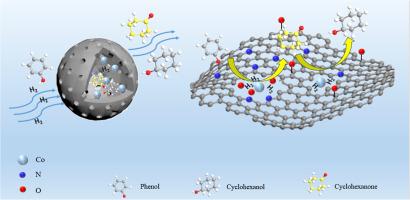非贵金属Co@hollow碳球通过温控结构工程高效一小时苯酚转化为环己醇
IF 3.9
3区 工程技术
Q3 ENERGY & FUELS
Chemical Engineering and Processing - Process Intensification
Pub Date : 2025-07-24
DOI:10.1016/j.cep.2025.110470
引用次数: 0
摘要
环己醇是一种重要的化工中间体,苯酚加氢合成环己醇是一种绿色高效的工艺。本文采用软模板法通过调节热解温度,合成了微环境可调的空心碳球纳米反应器([email protected], T: temperature)。表征分析表明,热解温度可以调节催化剂的缺陷密度和孔结构。结合实验结果和机理研究,发现氢和苯酚通过多级孔扩散进入催化剂腔内,提高了传质效率,高缺陷密度和高分散的钴纳米颗粒促进了氢和苯酚的活化和反应。[email protected] -600催化剂在140℃下反应1 h,苯酚转化率为88.9%,环己醇选择性为99.9%,具有显著的催化活性。[email protected] -600催化剂具有较高的缺陷密度(ID/IG=2.77)、较高的金属分散度(45.67%)、588 m²/g的比表面积和3.53 nm的平均孔径,是催化剂具有良好反应活性的主要原因。同时,[email protected] -600在催化多种木质素衍生单体和二聚体的氢化反应中表现出显著的普遍性。本文章由计算机程序翻译,如有差异,请以英文原文为准。

Non-noble metal Co@hollow carbon spheres for highly efficient one-hour phenol conversion to cyclohexanol via temperature-controlled structural engineering
Cyclohexanol is an important intermediate in the chemical industry and the synthesis of cyclohexanol from phenol by hydrogenation is a green and efficient process. In this paper, hollow carbon sphere nanoreactors ([email protected], T: temperature) with tunable microenvironment were synthesized by adjusting the pyrolysis temperature using soft template method. The characterization analysis demonstrated that the pyrolysis temperature could adjust the defect density and pore structure of the catalyst. When combined with experimental results and mechanistic studies, hydrogen and phenol were found to diffuse through multistage orifices into the cavities of the catalysts with enhanced mass transfer efficiency, and high defect density and highly dispersed cobalt nanoparticles were found to promote the activation and reaction of hydrogen and phenol. The [email protected]–600 catalyst shows significant catalytic activity at 140 °C for 1 h with 88.9 % phenol conversion and 99.9 % cyclohexanol selectivity. The good reaction activity of [email protected]–600 can be attributed to the catalyst's high defect density (ID/IG=2.77), substantial metal dispersion (45.67 %), a specific surface area of 588 m²/g, and an average pore size of 3.53 nm. Concurrently, [email protected]–600 demonstrated remarkable universality in catalyzing the hydrogenation of a diverse array of lignin-derived monomers and dimers.
求助全文
通过发布文献求助,成功后即可免费获取论文全文。
去求助
来源期刊
CiteScore
7.80
自引率
9.30%
发文量
408
审稿时长
49 days
期刊介绍:
Chemical Engineering and Processing: Process Intensification is intended for practicing researchers in industry and academia, working in the field of Process Engineering and related to the subject of Process Intensification.Articles published in the Journal demonstrate how novel discoveries, developments and theories in the field of Process Engineering and in particular Process Intensification may be used for analysis and design of innovative equipment and processing methods with substantially improved sustainability, efficiency and environmental performance.

 求助内容:
求助内容: 应助结果提醒方式:
应助结果提醒方式:


